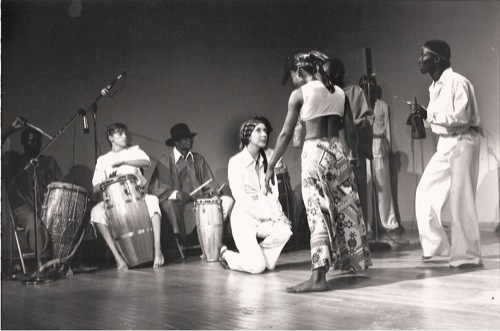
Makandal performance at Columbia University in 1983.
Lois Wilcken kneeling before a dancer posing as a spirit Chantal Regnault.
Tom Tom Magazine: How and when did you become interested in Haitian drumming?
Lois Wilcken: That is the kind of question that can take me all the way back to day one. The connection between music and healing always resonated for me. I had a guru at Hunter College—composer Ruth Anderson—when I was studying electronic music there in the ‘70s. She encouraged that interest and composed music designed to heal. I was very aware that music plays a tremendous role in healing in cultures outside those of elite European traditions. And so I began to study ethnomusicology, the only discipline within music that takes non-European music seriously, again at Hunter College. While doing a term paper on the bira, a healing ceremony among the Shona of Zimbabwe that uses the mbira (popularly called “thumb piano”), I read a book by a scholar named Sheila Walker that discussed spirit possession in Haitian Vodou, and its healing dimension. The following semester I had to do a field project in New York City. Knowing that a large Haitian community was living in New York, I chose Vodou music as my subject. I met up with master drummer Frisner Augustin, and the rest is history.
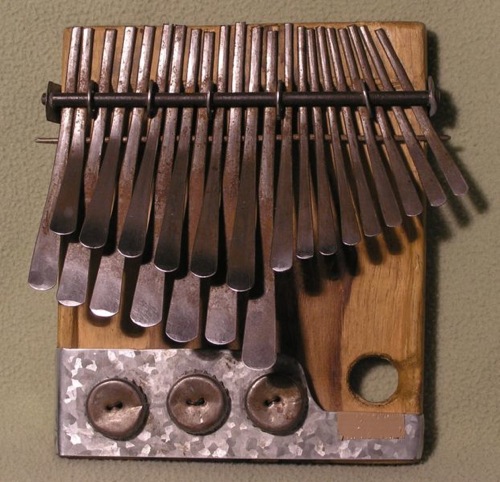
Mbira (Thumb Piano)
Tom Tom Magazine: Describe your involvement in the field, both academically and as a musician. Do you play the conga, boula?
Lois Wilcken: When I finished my Ph.D. in ethnomusicology at Columbia University in 1991, I decided not to go into an academic career but rather what we in the discipline call “the public sector.” We also call public sector work “applied ethnomusicology,” because we apply our theories in practical settings, like communities. My master’s thesis and my dissertation focused on the Haitian community in New York, and along the way I had forged very strong relationships with artists and lovers of art within that community. While researching Haitian folklore troupes for my dissertation, I took on the administration of Mr. Augustin’s company, La Troupe Makandal. I got the group incorporated, secured its non-profit status, and was developing programs with them when I graduated from Columbia. My academic colleagues were taking on tenure-track positions then, and it became very clear to me that I could never take on such a project as getting tenure and continue to work in the community at the same time. So I continued to work for Makandal, and I got a job with City Lore, a very successful Manhattan-based non-profit that researches and presents folk arts in New York City. City Lore became another education for me, because it served as a model for how a non-profit should run. Makandal benefited from my working for City Lore.
I never did abandon my academic work. I’m an active member of the Society for Ethnomusicology and the Haitian Studies Association. I present my research regularly at their annual conferences, and often at the conferences of the Latin American Studies Association and others in the field. I’ve had a book and many of my essays published, and World of Music, a distinguished, European-based scholarly journal, has scheduled one of my pieces for publication in 2010. A few years ago I created an exhibit for a facility in Guadeloupe, and you can see versions online in French and English. These tasks keep my scholarly life moving.
As for performing Haitian music, I usually leave that to professional musicians. In my work with Makandal, I satisfy my creative inclination through program development. I’ve written the scripts for several of the productions in our repertory, for example, Rising Sun, a three-part series with a death-and-rebirth theme that emerges from Vodou rites of autumn and winter. I do manage, however, to play for ceremonies—as opposed to stage performances—with our drummers. My instrument is the ogan, an iron timekeeper. (But I can play other parts as well). You have to be very focused to play ogan, but because the part demands the least variation of all the ensemble instruments, I can give a lot of attention to what is going on with the singers, dancers, audience, etc. I like that, and, yes, it’s healing.
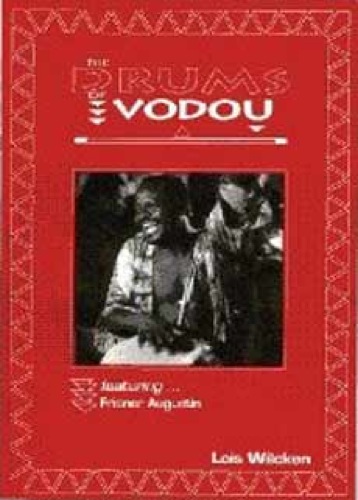
Drums Vodou by Lois Wilcken
Tom Tom Magazine: Describe your travels in the field. What are some of the most significant and interesting moments?
Lois Wilcken: The field presents two kinds of travel opportunities. Conferences take me to many interesting places. This year, for example, the Society for Ethnomusicology met in Mexico City. I’ve gone by invitation to colloquia organized by the International Council for Traditional Music in Jamaica, the Cayman Islands, and Cuba (twice). It’s very good to exchange research with scholars in the developing world—we can, despite our technologies, be very provincial in the United States. Of course, I’ve gone to conferences of the Haitian Studies Association in Haiti, although they usually meet in the United States. The Haiti conferences really remind us of the rich tradition of research Haitians have conducted on their own music and dance. And in 2005 La Médiathèque Caraïbes, based in Basse Terre, Guadeloupe, invited me to speak at a conference on their turf. I have since done some reading on Guadeloupe’s history, which parallels Haiti’s in some interesting ways, and I have a new research idea on my back burner.
Makandal performances provide the other kind of travel opportunity. We’ve played all over the United States and Canada, in Paris, and, in 2007, in Tokyo. Part of the magic of Tokyo was our discovery of Shinto. We had with us a manbo (female priest) and two of her closest associates in Vodou because the Tokyo Summer Festival asked us to stage ritual, something for which audience and presenters know Makandal. Mr. Augustin and myself are also initiates, and our musicians play regularly for Vodou rites. When we visited Shinto shrines during our time off, we could feel the connection. The style of Shinto is very different from Vodou, but its substance is close. I believe that humans share a spiritual foundation that became very obvious to me in Japan, and likely accounted for the Festival’s interest in having us play for them. That takes me back to the healing theme. What better practice than music and dance for healing the divisions among us?
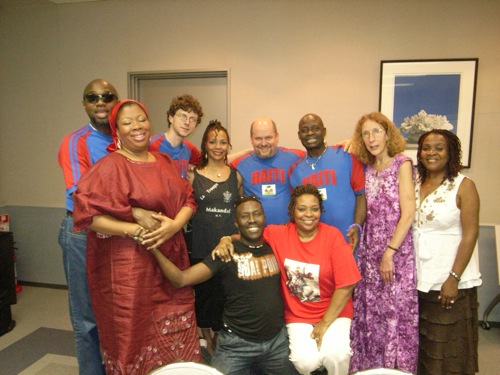
La Troupe Makandal backstage at the last performance we did in Tokyo (2007)
Tom Tom Magazine: What are you currently working on/researching?
Lois Wilcken: At the moment I’m annotating ten hours of video from my fieldwork collection for a project called Ethnographic Video for Instruction and Analysis Video Archive (EVIADA), an online database established at Indiana University in Bloomington. The collection consists of video recordings of Vodou rituals that I made in Port-au-Prince in the 1990s. When it’s finished and added to the EVIADA web site, the end-user will see the entire time-line segmented into events and then scenes. He/she can go into any segment and read a thorough description of the content. EVIADA designed the project for researchers and educators.
I’m also at work on a Haitian instrument collection for the Musical Instrument Museum, which will open in Phoenix in April. In January 2009 Frisner and I went to Port-au-Prince to buy the collection. It was an adventure! We bought nearly all the instruments from a oungan (male priest) in a little town called Bizoton. His grandfather established his temple on the heels of a notorious anti-Vodou case that happened there in the nineteenth century. But the temple thrived, and the instruments he provided will beautifully represent Haiti in the Museum. I’ve been busy researching audiovisuals to enhance the exhibit, and I wrote the text for the exhibit signage. It’s likely Makandal will play at the Museum next year.
My current project with Makandal brings dancers and musicians together to perform some two dozen traditional dances in two performances in the spring. Many, if not most, of these dances are going extinct. We intend to video them, then produce a DVD and some web materials that will document them for a long time to come and perhaps generate a revival of those least seen today. We call the project Haiti Drum and Dance, and we’ve won support from the National Endowment for the Arts and the New York City Department of Cultural Affairs.
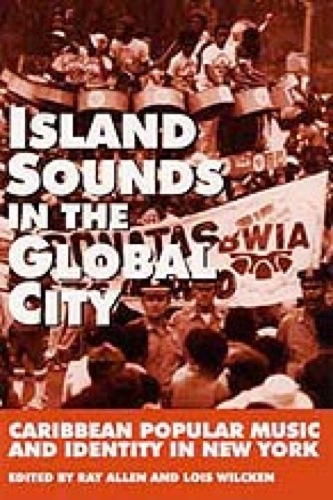
Tom Tom Magazine: Has being a woman in this field affected your experience? Or is it not an issue?
Lois Wilcken: I’ve been fortunate on two counts. First, Vodou is one of the world’s most progressive forms of spirituality in that a woman can go to the top of the priesthood. Can you imagine recognizing and rewarding the spiritual potential of women in the Judeo-Christian religions or the great religions of Asia by making women bishops, popes, and imams? What a coup that would be! Women are spiritual leaders in Haiti. On the other hand, not many women drum in Haiti. The culture recognizes them as superb singers, but men drum almost exclusively. And that brings me to the second count of good fortune. Master Drummer Frisner Augustin generously shares his art with women, and several women have drummed at Vodou rites in New York. Vodou does not encourage women to drum, but unlike Santería and other related practices, it does not proscribe drumming by women. So Frisner will include in his ensemble any woman who is musical and loves the culture. As for fieldwork, I’ve never felt limited in conducting it because I’m a woman.
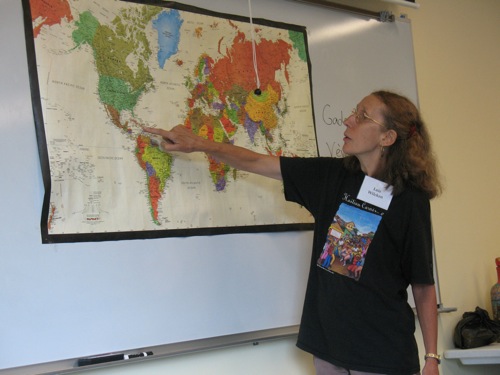
Lois at a workshop on Haitian music and art (2008)
Tom Tom Magazine: Do you have any thoughts about the Haitian drumming in relation to women, history, musicology, feminism, theory, or psychology?
Lois Wilcken: My thoughts are about Vodou as a cultural whole, because one can’t detach the drumming from it. Vodou embodies the country’s history. Each of the dances, and the drumming and song styles that work with them, represents the historical experience of a people brought by force to labor on colonial plantations. Each carries both memories from Africa and memories of the experiences of slavery and liberation. To expand on what I said before, the voices of women are strong in Vodou, as are those of homosexuals, bisexuals, the poor, and other disenfranchised groups. Vodou honors ancestors, the living, and the generations to come. To quote a former New York mayor [David Dinkens], what a “gorgeous mosaic”!
The dance forms, the melodic modes, the drum ensemble patterns, and the tonal spectrum are as diverse as the peoples who made Haiti. It behooves scholars to pay attention to such elements of Vodou as the drumming because they serve as keys to something we all so desperately need in an age of cultural homogenization: the antidote of diversity and egalitarianism. And while an understanding of Vodou can be so crucial to communities and nations, it also serves the needs of individuals. Vodou has elaborated an amazing theory of the soul and its relation to the cosmic whole. We can easily argue that Vodou is psychology because it guides an individual to self-realization. And that brings us back to healing. Vodou is healing; Vodou drumming is healing.
Exclusive Tom Tom Magazine Interview by: FonLin Nyeu, a member of Dragons of Zynth & founding member of Chica Vas an all female percussion group made up of Brooklyn’s finest lady musicians. She believes in the healing power of the drums.

